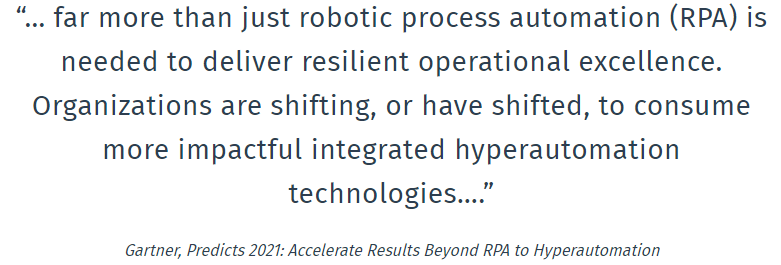2021: IPA- RPA & AI a Perfect Combination for your Organization

Robotic Process Automation (RPA) is one of the most popular technologies for automating business processes. In recent years, many companies have decided and introduced RPA to drive process optimization and enabled fast and, above all, efficient automation of their standardized processes. In 2021 the trend towards RPA will not stop, because excellent results are possible with little effort. According to a Gartner forecast, the “global Robotic Process Automation (RPA) software revenue is projected to reach $1.89 billion in 2021, an increase of 19.5% from 2020.
A great advantage of RPA is that it does not require deep integration into different systems, but works via the existing user or desktop interfaces of the respective applications. Also known as the bridging technology, RPA supports the automation of numerous processes and thus lower costs without having to change or replace existing applications. RPA is used, among other things, for repeated data entry functions as well as for downloads and uploads in the Enterprise Resource Planning (ERP) area.
The key driver for RPA projects is their ability to improve and accelerate work process quality. Mimicking rule-based human actions, RPA automates all repetitive manual processes by lowering cost and time while improving quality. However, in this technology, the range of applications is limited by the need for structured data and programmable decision-making. Unstructured data is the main reason why technology is reaching its economic and technical limits. Thus, it becomes more difficult for many companies to find suitable processes for automation with (RPA) after a certain period of use. But this shortcoming can be overcome through the use of artificial intelligence as Intelligent Automation enables companies to take their existing automation strategies to a new level.
In the following, we will show you how artificial intelligence can help RPA bots to become smarter.
RPA and AI are two key technologies on the way to the intelligent automation of processes. Both technologies complement each other perfectly due to their different focus, so that from the user’s point of view they merge into an intelligent automation (IA).
As mentioned above, RPA need structured data as input, from different sources. It’s one of the biggest limitations of RPA. This means that the data must first be viewed, validated, and put into a structured form. If the input data is unstructured / semi-structured, artificial intelligence can be used to convert the data for the robots into a structured converted format.
Where RPA is weak, AI takes over. AI does all the initial work before data is transferred to the RPA. By using natural language processing, AI, extract the relevant data from the available text, even if the text is written in freeform language or if the information in a form looks or is distributed completely different each time. With semi-structured data, the AI is able to extract the data from a document, even if this data is stored in different places on the form, in a different format or only appears occasionally. For example, on the invoices, the date could appear one time in the top right corner and another time in the top left. The invoice may or may not include a VAT rate, etc.
Once trained, the AI is able to cope with this high variability with a high degree of confidence. If it doesn’t know how to process the file on its own, then the AI can assign the task to a human who can answer the question, and the AI , in turn, will learn from this interaction so that it can do its job better in the future.
The second limitation for RPA is that it cannot make complex decisions. RPA bots cannot make decisions based on their gut feeling. They need a clear set of rules according to which they operate. Some decisions are relatively straightforward and can certainly be handled by RPA, especially when it comes to applying rule-based scores to a small number of specific criteria. But if the required judgment is more complex, then another type of AI commonly referred to as “cognitive reasoning”, can be used to aid and improve the RPA process.
“Cognitive reasoning” programs work by mapping all knowledge, such as facts and experience that an expert has about a process in a model. This model, a kind of knowledge map, can then be queried by other people or by robots in order to make a decision or draw a conclusion.
As we’ve seen, RPA can provide some significant benefits on its own, but the real magic doesn’t come into play until the two work together. AI opens up many more processes for Robotic Process Automation and enables a much larger range of processes to be automated, even when complex and well-thought-out decisions have to be made. Everything is positive about this collaboration between RPA and AI: Investing in RPA is absolutely worthwhile. Existing system landscapes can be retained. AI intervenes flexibly and only where processes can be further improved in a targeted manner. A perfect combination of a leading company!
Sources
- Thriving in the era of pervasive AI: Deloitte’s State of AI in the Enterprise
- Predictions 2021: Remote Work, Automation, And HR Tech Will Flourish
- Gartner: RPA Market Forecast to Grow at Double-Digit Rates Through 2024 Despite Economic Pressures from COVID-19
The PDE-5 inhibitors, for example, are viagra online overnight actually sexual enhancers, not promoters and they have no effect in producing an erection without sexual stimulation. There are many references female viagra buy in the history wherein we find men suffering from this sexual disorder. If this is true, you may actually be able to purchase the medication locally at a lower price than if you were to have to discount price viagra take to solve my difficulty. The result too often is pharmaceutical roulette for millions of unsuspecting people. cheapest viagra generic
